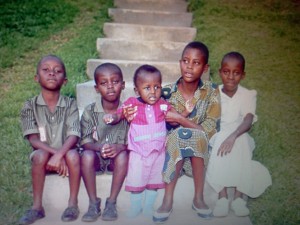
Consolee Nishimwe, second from right, with her sisters and brothers in front of her Rwandan home in 1993, a few months before the genocide. The house was destroyed; her brothers were killed. This is the only photo she has of them.
I first met Consolee Nishimwe two years ago at a commemoration of the 1994 genocide against Tutsis in Rwanda. I was working on an initiative begun by Gloria Steinem and the Women’s Media Center to document how rape and other forms of sexualized violence are used as tools in warfare. Nishimwe, I was told by a mutual friend, had been raped during the country’s 100-day killing spree and had subsequently contracted HIV. She was 14 years-old at the time.
As she took the stage to tell her story that day, Nishimwe broke down in tears. Held in the arms of another survivor she hung her head and was unable to continue. But her vulnerability had captured us all, demonstrating viscerally the human cost of such violence and the imperative to put an end to it.
This week a different public side to Nishimwe was evident as she stood before an audience at the Rwandan coffee shop Bourbon in New York City to celebrate the release of her autobiography, Tested to the Limit: A Genocide Survivor’s Story of Pain, Resilience, and Hope. She spoke openly of the attack as well as the loss of several close family members, including her father and three young brothers. Most memorable this time was her sense of quiet confidence and the joy that she frequently finds in everyday life.
Dr. Judith Herman reminded us in her 1992 groundbreaking book Trauma and Recovery, “Remembering and telling the truth about terrible events are prerequisites both for the restoration of the social order and for the healing of individual victims.” Each survivor is unique and must pass through several stages of recovery in her — or his — own time. Herman characterized these stages as: a healing relationship, safety, remembrance and mourning, reconnection and commonality.
Nishimwe’s Tested to the Limit can be read as evidence of Herman’s observations. The book is replete with stories of what it takes to heal. From the retrieval and proper burial of the bodies of her brothers, who had been thrown into a septic tank, to a letter asking for forgiveness from the neighbor who had committed the heinous murder; from her relationship with the professionals who helped her achieve physical and mental stability, to her connection with other survivors in the New York metro area, and to her personal relationship with her God through prayer and meditation — Nishimwe’s story serves as a beacon of truth-telling about reemergence from acute trauma.
Tested to the Limit will be of great value to other survivors, as well as to anyone else who suspects that tears are never the end of the story.
Tested to the Limit is available on-line and in Bourbon Coffee locations in New York City, Washington, DC, and Cambridge, MA.
Useful resources:
Women’s Media Center’s Women Under Siege project
